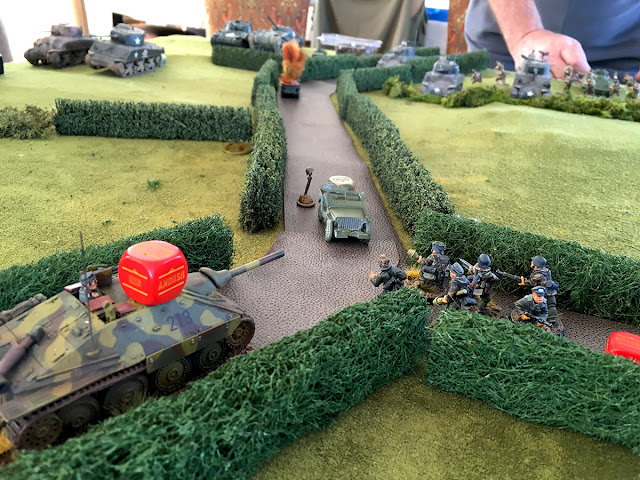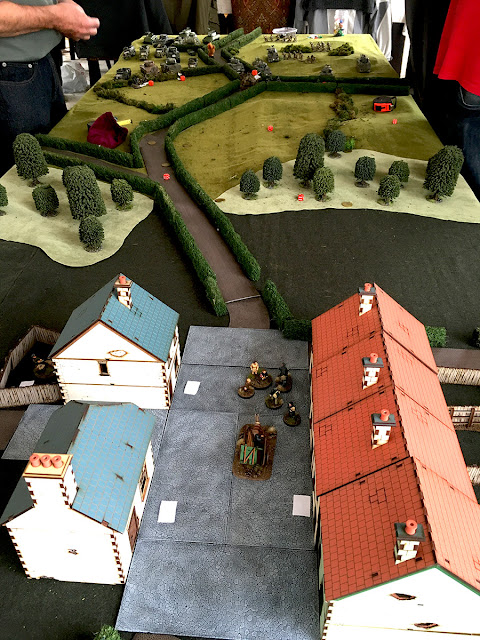 |
First line of defence: Heer veterans make the Allies pay for every yard of their advance.
|
Here are some images from a recent large Bolt Action game played by members of the Peninsula Wargames Group. Based on broadly on Operation Cobra - the American breakout from St Lo in 1944 - the game involved two tables of 12ft x 4ft, and six distinct commands. Each command had a separate objective and distinct VPs: Two American forces, one on each table, had to race each other to break through along the length of the table - scoring VPs only for exiting the board. On each table, a limited Heer force had to maximise US casualties, while conducting a fighting withdrawal off the length of the table. There were also two SS forces, that had to cross the width of both tables, securing VPs only for exiting units off board. About 10 players were involved, in addition to a game umpire. Players were given their orders and list restrictions in the days ahead of the game, so their forces were optimised for the terrain and the objectives. I have no idea as to how many points were on each table, but I know my Heer force was 1500pts and felt outnumbered by at least three to one...
 |
| Table One. Round "dunkelgelb" markers indicate deployment positions of one Heer force, while paper markers indicate positions of their second line of defence. Some SS elements have arrived on the left flank. |
 |
| Table Two. Again, round "dunkelgelb" markers indicate deployment positions of forward Heer force, while paper markers indicate positions of the regimental HQ. Red dice identify map zones for USAAF attacks. |
What really added value to this game were layer upon layer of scenario special rules applied to the core rules. Line of sight rules were adapted to emphasise the difficulties of advancing through bocage country. The use of blind markers and dummy blind markers - in addition to the standard hidden and dug in rules - helped to increase the fog of war for the US players, and better represent ambush-based fighting. Panzerfaust-equipped small tank-hunter teams were allowed. Bazookas integrated into mechanised infantry squads were allowed. To represent US air superiority airstrikes arrived at the start of every turn, not just when called by FOAs. Spotters were allowed to call in strikes from within vehicles. The umpire made sure that civilians clogged some roads. And that partisans ambushed SS forces. It was a mess.
What I loved was the in-game effect of giving different commanders wildly different objectives. Pre-game discussions of strategy between the Heer players and SS players resulted in no agreement - a satisfying representation of conflict between the various service branches. From turn to turn the German players agreed on tactical approaches, to ensure overall victory, but only co-operated while it was mutually beneficial... And all the while the Americans were in a race through difficult country, populated with Heer units that had no hope of defeating the US, but well equipped to slow them down.
It was a huge, multi-faceted, chaotic, wonderful game, and was Bolt Action at its best.
 |
| The difficulties of advancing through bocage country... and the arrival of the SS complicates the allied picture. (Pic courtesy of Anthony van Dijk.) |
 |
| GIs prepare to discourage panzerfaust attacks on the advancing armour. |


